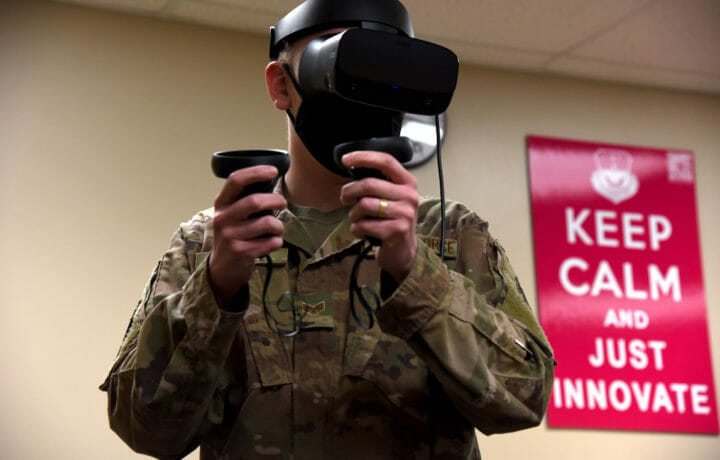As one of the younger military services, the United States Air Force has long been at the forefront of technological innovation and in 2021, it is taking it to heart with its new “Innovation Lab,” which opened last month at Malstrom Air Force Base (AFB), Montana.
The dedicated space was designed to allow Airmen to focus on innovative ideas where they can turn their ideas into tangible solutions through research and even by corresponding with other Department of Defense (DoD) organizations, academic sources, and commercial partners.
The new lab, which is housed in a large conference room equipped with Wi-Fi enabled tablets as well as virtual reality (VR) headsets and drafting software, is overseen by Wing1Werx. The group was established a year ago in February 2020 as part of AFWERX, an Air Force and DoD global initiative to foster a culture of innovation and to engage with new entrepreneurs in the Air Force ecosystem.
The overreaching goal of the innovation hub is improve the daily working lives of Airmen and to serve the mission by improving wing efficiency and lethality.
“The Innovation Lab is for Airmen who recognize solvable issues or problems with processes in their workplace,” said Capt. Joseph S. Hap, 341st Missile Wing Innovation lead.
Hap, who has worked diligently alongside the organization’s leadership team to expand the opportunities for Airmen, said he believes the addition of the new lab is a big plus for the Air Force.
“Anyone can participate in innovation, and this lab can be where the rubber meets the road,” Hap added.
Almost Rocket Scientists and More
Wing1Werx has already proven to be crucial to the intercontinental ballistic missile mission at Malmstrom AFB. In September 2020, an idea suggested a Wing1Werx convention was tested as an implemented tool for security forces Airmen defending the base’s 13,800 square-mile missile field.
Two Airmen, 1st Lt. Daniel Cook, 341st Security Forces Group commander executive, and Tech. Sgt. Daniel Bratt, 341st Missile Security Forces Squadron NCO in charge of operations support, began brewing up ideas to assist the 341st Missile Security Operations Squadron tactical response force and missile field defenders while attending a trip to a Combat Air Force Weapons and Tactics seminar.
While the idea that Cook and Bratt proposed ended up taking second place at the convention, wing leadership still pushed forward their idea and ensured it would receive funding to test the tool’s new capabilities against current recapture and recapture operations.
More recently, two Airmen at Malstrom proposed a rappelling system used to enter missile launch facilities, an idea that won second place at another quarterly award competition; while the proposed Air Force eSports has already been implemented across the force.
“We want Airmen to start with an idea, flesh out that idea, do some brainstorming and see which method or means could be used to bring that idea to fruition,” Hap suggested, and that a permanent lab could be a place for such innovation. “Your work-related problems and the subsequent solutions are the fuel for this program that we want to make available for years to come.”
Innovation Hub at Scott AFB
The hub at Malstrom AFB is just one of such new hubs for innovation. Elevate, a new innovation hub at Scott AFB, Illinois, also received Air Force approval to be designated a defense laboratory in January. It will serve as the first Air Force innovation cell to become an official defense lab for technology transfer purposes.
The new designation as a defense lab will allow the Elevate team to partner with educational institutions under an Education Partnership Agreement (EPA) in sharing resources, equipment and information.
“The biggest win for Scott AFB is that the designation as a defense lab will permit us to engage in EPAs with local universities,” said Capt. Austin Duncan, Elevate’s deputy innovation officer, via a statement.
“These EPAs allow us to collaborate with these universities using equipment and manpower where we normally do not have access,” Duncan added.
EPAs were created to help increase national technological and economic competitiveness by promoting increased interactions between defense labs and educational institutions, the Air Force Technology Transfer Handbook explained. Such partnerships can help foster a culture to cultivate, recruit, and diversify the Air Force workforce.
The next step for the Elevate team is to partner with Southern Illinois University Edwardsville on the first EPA.
“Once we enter into that agreement, we will have access to their facilities and staff to work on potential problem sets that are outside of our organic capacity,” Duncan said. “The university, likewise, will be able to have access to some of the equipment we have.”
This will likely be the first EPA for the Elevate team, which will seek similar partnerships with other universities in the area.
Other Hubs
In December, the Department of the Air Force also designated new hubs including the new SpaceWERX innovation hub, based at Los Angeles ARB, which will foster efforts to bring startups and cutting-edge commercial tech into the Space Force’s industrial base.
In addition, the Air Force designated Dayton AFB, Ohio to be an Innovation “Digital Hub,” which was meant to open doors to greater cooperation between private-sector innovators and Air Force decision-makers.




